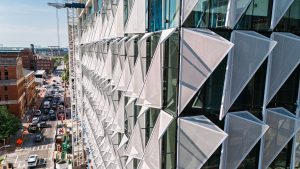The Role of Fabric Facades in Sustainable Architecture
Uncategorized
Sustainable design is no longer a trend, it’s a necessity. As architects, builders, and developers look for innovative ways to reduce environmental impact while creating visually stunning structures, fabric facades have emerged as a powerful solution. Combining advanced engineering with modern aesthetics, fabric facades offer both functional and environmental benefits that make them a standout feature in green building strategies.
At Tensile Structure Systems, we specialize in designing and installing high-performance fabric solutions that support a more sustainable built environment.
What Is a Fabric Facade?
A fabric facade is an exterior cladding system made from high-strength, durable membrane materials, often tensioned over a lightweight structural frame. Unlike traditional building materials such as concrete, brick, or steel, fabric membranes are lightweight, flexible, and highly efficient, making them ideal for both permanent and temporary applications.
These systems are frequently used for shading, energy control, and aesthetic enhancement on both new and existing buildings. Whether wrapping an entire structure or accenting specific areas, fabric facades contribute significantly to a building’s performance and environmental footprint.

Energy Efficiency Through Passive Climate Control
One of the most significant benefits of fabric facades is their ability to regulate temperature naturally, reducing a building’s reliance on mechanical heating and cooling. By filtering sunlight and allowing for controlled airflow, fabric facades:
- Minimize solar heat gain during warmer months
- Reduce glare and UV exposure
- Lower indoor cooling demands and energy consumption
- Support natural ventilation strategies
This passive climate control can lead to significant energy savings over time, helping projects meet green building standards such as LEED and other sustainability certifications.
Lightweight Materials with a Smaller Carbon Footprint
Compared to conventional cladding systems, fabric membranes are far lighter, which means less material is required to construct the supporting structure. This not only lowers transportation and installation energy costs, but also reduces the overall embodied carbon of the project.
Many modern tensile fabrics are engineered to have long lifespans and can often be recycled at the end of their use, aligning with circular design principles that prioritize waste reduction.
Enhancing Daylighting While Reducing Energy Use
Natural light plays a crucial role in sustainable design. Fabric facades can diffuse daylight evenly throughout a space, creating bright, comfortable interiors while minimizing the need for artificial lighting. Unlike traditional glazing or solid walls, tensile membranes allow filtered light to pass through without overheating indoor spaces, making them ideal for:
- Educational and cultural facilities
- Sports and recreation complexes
- Commercial buildings and offices
- Transportation hubs
This combination of light transmission and thermal performance supports energy efficiency and occupant well-being.
Adaptive Design for a Changing Climate
Sustainability isn’t only about energy use, it’s also about adaptability. Fabric facades can be custom-engineered to respond to environmental factors such as sun orientation, seasonal temperature shifts, and prevailing winds. Their modular design allows for easy updates or modifications over time, ensuring the structure can evolve with changing needs and performance goals.
Aesthetic Versatility That Supports Sustainable Goals
Beyond their performance advantages, fabric facades offer exceptional design flexibility. They can be formed into dynamic shapes and curves, creating iconic architectural statements without the heavy environmental cost of traditional materials. This allows architects and developers to balance visual impact with environmental responsibility, a critical factor in modern sustainable design.
Supporting Green Certifications and Long-Term Savings
Many projects incorporating fabric facades see benefits that extend far beyond initial construction. These systems can help support green building certifications by contributing to credits in areas such as:
- Energy and atmosphere performance
- Sustainable materials and resources
- Indoor environmental quality
- Innovation in design
Additionally, lower energy usage and reduced maintenance needs contribute to long-term operational savings, making fabric facades a smart investment both environmentally and financially.
Partner with Tensile Structure Systems for Sustainable Design
At Tensile Structure Systems, we collaborate with architects, builders, and designers to create high-performance fabric facade systems that meet modern sustainability goals. Our expert team delivers solutions that are durable, energy-efficient, and visually striking, helping shape the future of sustainable architecture.
Ready to bring your next project to life with innovative tensile design? Contact Tensile Structure Systems today to learn how fabric facades can transform your building’s performance and environmental impact.
